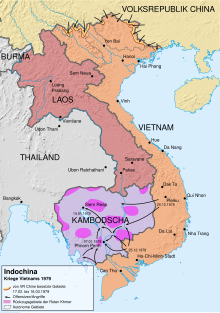Cambodian-Vietnamese War
| date | December 25, 1978 to September 26, 1989 |
|---|---|
| place | Cambodia |
| output | Withdrawal of the Vietnamese occupation forces from Cambodia |
| Parties to the conflict | |
|---|---|
| Commander | |
|
Lê Duẩn
|
|
The offensive by Vietnamese troops to end the terrorist regime of the Khmer Rouge in 1978/79 and the subsequent Vietnamese occupation and the guerrilla war in Cambodia until 1989 is referred to as the Cambodian-Vietnamese War .
Causes and Reason
Since 1977, the Democratic Republic of Kampuchea under Pol Pot has been involved in border disputes with Vietnam. The Pol Pot regime also persecuted ethnic Vietnamese and threatened to invade Vietnam in its propaganda. When Heng Samrin fled to Vietnam after the executions of tens of thousands of Khmer Red fighters in the east and asked for help, the Vietnamese army intervened in late 1978.
course
The first fighting began as early as December 11, 1978. The official start of the offensive by Vietnamese troops to end the terror regime of the Khmer Rouge was December 25, 1978. During the invasion, 13 Vietnamese divisions with a total of around 150,000 soldiers were deployed. Although the Khmer Rouge had been upgraded financially and materially by the People's Republic of China , they were so inferior to the Vietnamese in direct combat that the Vietnamese army had already captured half of Kampuchea after two weeks. On January 7, 1979, the Vietnamese conquered the largely deserted Phnom Penh . The remaining units of the Khmer Rouge withdrew to northwestern Cambodia and began a new guerrilla war. In return, on January 10, 1979, the People's Republic of Kampuchea was proclaimed under the "United Front for the National Salvation of Cambodia" headed by Heng Samrin .
China saw its regional power interests endangered by the steps of Vietnam, since it feared an Indochina federation bound to the Soviet Union under the rule of Vietnam. It intervened briefly in the Sino-Vietnamese war to persuade Vietnam (unsuccessfully) to withdraw its armed forces from Cambodia. One day after the Chinese invasion, the governments of Vietnam and the People's Republic of Kampuchea concluded a cooperation and friendship treaty on February 18, 1979. The country was largely dependent on Vietnam. Samrin also had to allow the occupying power to station troops. The new republic was only recognized by a few states from the Eastern Bloc and the Third World.
A decade of guerrilla war followed, in which other groups were also involved on the side of the Khmer Rouge under Khieu Samphan . The former prime minister Son Sann was formed the National Liberation Front of the Khmer (Engl. Khmer People's National Liberation Front , KPNLF) to lead the political struggle for Cambodia's independence. She was also loyal to Prince Sihanouk and formed a military arm, the Khmer People's National Liberation Armed Forces (KPNLAF). Sihanouk founded his own organization in 1981, FUNCINPEC (French for Front Uni National pour un Cambodge Indépendant, Neutre, Pacifique, et Coopératif ), with the military arm Armée nationale sihanoukienne (ANS). The two organizations, which consisted of groups that had fought the Khmer Rouge after 1975, including soldiers from Lon Nol , formed the non-communist resistance. Together with the Khmer Rouge, in 1982 they formed the coalition government of the Democratic Kampuchea in Exile, which was internationally recognized as the legitimate government of Cambodia and occupied Cambodia's seat in the UN. The groups also managed to control smaller areas in the western border area with Thailand.
The End
Hun Sen , who had replaced Heng Samrin at the head of the People's Republic of Kampuchea in 1985, entered negotiations with Prince Sihanouk in 1988 to form a new joint government. International pressure, but also the economic weakness of the Soviet Union , which also had an impact on Vietnam, prompted the Vietnamese to agree to the withdrawal of the occupation troops by the end of the year at the Paris conference in 1989. The last Vietnamese troops left Cambodia on September 26, 1989. After 1989, with the participation of the UN, a peace agreement and the rebuilding of state structures followed, which ended in 1993 with a new constitution and the restoration of the monarchy .
literature
- Alexander Goeb: The Cambodia Drama. God-Kings, Pol Pot, and the Late Atonement Process. Laika, Hamburg 2016, ISBN 978-3-944233-50-5 .
Individual evidence
- ↑ Stephen J. Morris: Why Vietnam Invaded Cambodia. Political Culture and Causes of War. Stanford University Press, Chicago 1999, ISBN 978-0-8047-3049-5 , p. 111.
- ↑ University of Göttingen: The development of Vietnam since 1976 and today's political position in Southeast Asia ( Memento of April 10, 2005 in the Internet Archive )
- ^ Russell R. Ross: The Khmer People's National Liberation Front. In: Cambodia. A Country Study. Library of Congress Country Studies , Washington 1987.
